University at Buffalo
Behavioral Model of Loudness Intolerance
High-level noise causes discomfort for typical-hearing individuals. However, following cochlear damage, even moderate-level noise can become intolerable and painful, a condition known as hyperacusis.
One of the critical requirements for understanding and finding a cure for hyperacusis is the development of animal models. I have developed two new animal behavior models to study the pain and annoyance components of hyperacusis. The Active Sound Avoidance Paradigm (ASAP) uses a mouse’s innate aversion to a light open area and preference for a dark enclosed box. In the presence of intense noise, the animal shifts its preference to the light area. The Auditory Nociception Test (ANT) is based on a traditional pain threshold assessment. Although animals show an elevated pain threshold in the presence of 90 and 100 dB, at 110 and 115 dB they show a reduced pain tolerance. Using these two tests together will allow me to assess emotional reactions to sound as well as the neural interactions between auditory perception and pain sensation.

















